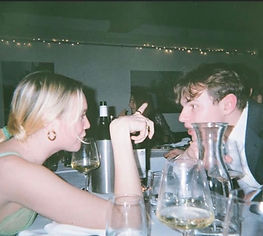
Casual Instagram is an Even Greater Performance
Elizabeth Nowak
A comment left underneath a video inspired TikTok user @cozyaliki to argue that those seemingly candid photos, posted on your favourite influencers’ pages, are an even better performance than the posed celebrity portrait. He explains the difference between a casual and a posed Instagram using the analogy of reality TV versus the typical television programme: both are staged, scripted programmes, yet reality TV aims to convince its viewers they are watching real life. Contrastingly, any other TV show is consumed by the viewer with a ‘suspension of disbelief’, a term coined by Samuel Coleridge that describes a transaction between audience and entertainer, where the audience chooses to believe an implausible story in return for being entertained. Like reality TV, a casual Instagram feed undergoes ‘scripting’ as its images are often strategically shot and are the perfect image selected from many. Intended to be consumed as a narrative of one’s life, these performances are often the very opposite of casual. The relevance in this topic is found in its participants – it is not only celebrity personalities and influencers who ask their viewers to believe in a scripted reality, the average Instagram student user does too.
The casual Instagram trend has undoubtedly taken off amongst the Durham student body, a trend that has seen a move away from solely sharing the highlights of their lives to a more casual approach, increasing exposure of their day-to-day life. A key component of the casual Instagram is the ‘photodump’, a utilisation of Instagram’s carousel post feature, posting up to 10 ‘candid’ photographs per post. The photodump can initially be seen as a means of liberation, an alleviation of posting pressure, affording the Instagram user freedom from the scrutiny and filtering of photographs to be selected for posting. Rather, the term ‘dump’ goes beyond this, with its connotations of a complete lack of thought in the pictures shared. This is not the case in practice. So very often the ‘dumps’ we see are slideshows of carefully curated images, selected for their aesthetic quality. Concern with the ordering of carousel posts can be seen in online tutorials providing instructions on how to adjust the order of images after posting. This demand for retroactive editing is evidence of the intentionality that goes into posts, intentionality that is passed off as effortlessness.
The average student is far more likely to use Instagram for personal sharing, that is if they choose to post anything. After all, Durham is better known for its other stereotypes than being the home of influencers. However, irrespective of one’s posting habits, every Instagram user consumes the content of other users and is thus susceptible to the old comparison game. Comparison to our peers is hardwired into us, a part of human nature. The late psychologist Louis Festinger, of the University of Iowa, developed the ‘Social Comparison Theory’, revealing that we compare ourselves to those around us to self-evaluate. In short, the impressions you take in of those around you are the basis of comparison which hold power to shape the way you think about yourself. And so, the casual Instagram trend not only leads us to believe in a false reality of our friends’ lives but also negatively affects the way we see ourselves.
A picture may say more than a thousand words, but it cannot tell them all. Photographs of aesthetic quality are not harmful but can become so when they are used to fuel comparison in the belief that they can accurately tell an account of any person’s life. Just as reality TV is scripted, so is the casual Instagram feed. Awareness of the even greater performance a casual Instagram post demands can help keep that habit of comparison in check. Enjoy it as entertainment rather than reality.
